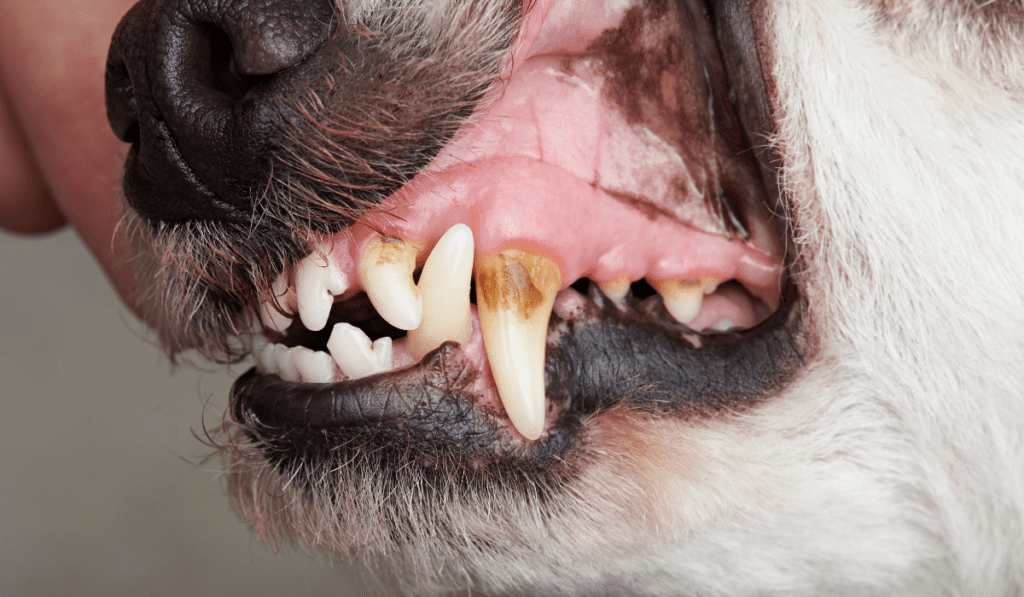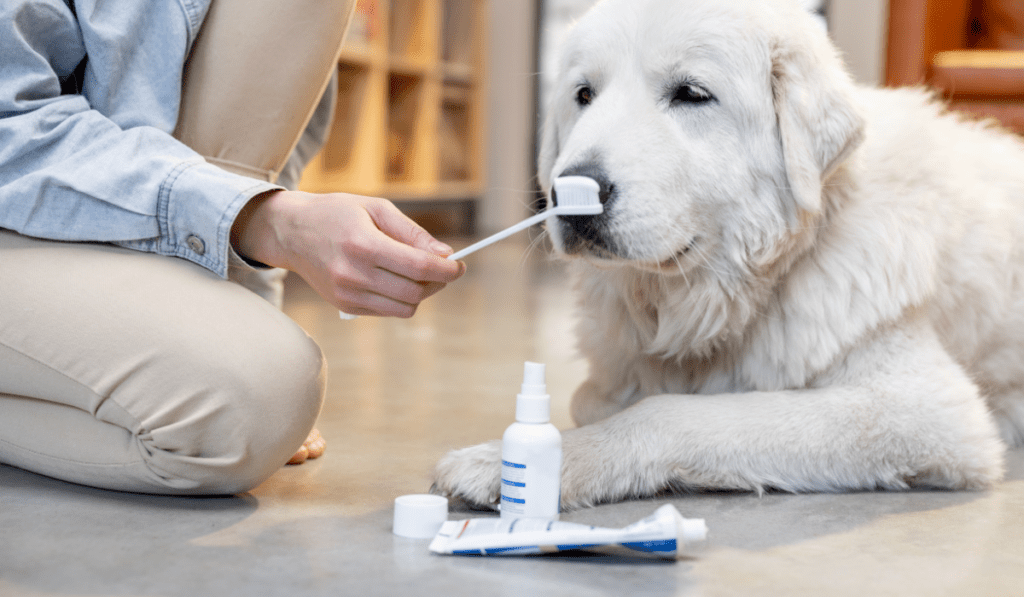Bleeding gums in dogs are often a sign of underlying oral health issues. Similar to humans, this condition indicates inflammation and potential infection in the gums. When dogs gums bleed when brushing easily, it typically points to a condition known as gingivitis, which is reversible with proper care. However, persistent bleeding or bleeding accompanied by other symptoms can signal more serious problems such as periodontal disease, infections, or even oral tumours.
Why Do Dogs Gums Bleed When Brushing | 6 Common Causes
So, why do dogs gums bleed when brushing? Have you noticed your dog’s gums bleeding recently? Understanding the causes behind this issue is crucial for knowing whether it’s a minor concern or something requiring veterinary attention.

1. Puppy Teething
Teething is a natural developmental stage in puppies, typically between three and eight months. During this period, puppies lose their baby teeth to make way for adult teeth, which can cause discomfort and irritation in their gums. Learn more about How to Maintain Dog Oral Health Without Brushing.
As new teeth erupt through the gums, it’s common for puppies to experience mild bleeding and discomfort. This process usually resolves once teething is complete, which can take several months.
To alleviate teething discomfort, provide appropriate chew toys designed for teething puppies. These toys help massage the gums and relieve the urge to chew on other objects, which can inadvertently cause gum injury and bleeding.
2. Cuts and Scrapes on Your Dog’s Gums
Dogs can occasionally injure their gums through rough play, chewing on hard objects, or even accidentally biting their gums. Minor cuts and scrapes on the gums may result in temporary bleeding.
These injuries typically heal quickly with minimal intervention, but it is important to monitor them closely for signs of infection, such as increased swelling, pus discharge, or reluctance to eat.
Inspect the affected area carefully if you suspect an injury to your dog’s gums. Clean the wound gently with a saline solution or an antiseptic recommended by your veterinarian. Avoid using human oral care products or harsh chemicals, as these can be harmful if ingested by your pet.
3. Abscess in Your Dog’s Mouth
An abscess in a dog’s mouth is a localized infection that can develop from various causes, including untreated gum injuries, puncture wounds, or dental diseases. When bacteria enter a wound or damaged tissue, they can multiply and form an abscess, which often appears as a painful swelling filled with pus. Abscesses in the mouth can lead to bleeding gums, particularly around the affected area.
If you notice swelling, redness, or persistent bleeding around your dog’s gums or face, it could indicate the presence of an abscess. Veterinary attention is crucial to draining the abscess and prescribing antibiotics to eliminate the infection. In severe cases, surgical intervention may be necessary to remove infected tissue and prevent further complications.
4. Gum Disease in Dogs
Gum or periodontal disease is one of the most common causes of bleeding gums in dogs. It occurs when plaque and tartar build-up on the teeth, leading to inflammation of the gums (gingivitis) and, if left untreated, progressing to periodontitis, which involves the loss of tooth-supporting structures.
Early signs of gum disease include swelling and red gums that bleed easily, especially during brushing or chewing. As the disease advances, your dog may experience bad breath, loose teeth, and difficulty eating. Small breed dogs and those with crowded or misaligned teeth are particularly prone to gum disease due to difficulty cleaning between teeth.
Preventing gum disease involves regular dental care, including daily brushing with a pet-specific toothbrush and toothpaste and annual dental cleanings performed by a veterinarian. These preventive measures help remove plaque and tartar buildup before they can cause irreversible damage to your dog’s gums and teeth.
5. Rotting Teeth
Rotting or decaying teeth can contribute to bleeding gums in dogs, especially if the decay extends to the roots of the teeth or surrounding gum tissue. Poor oral hygiene and factors such as diet and genetics can accelerate tooth decay and increase the risk of gum inflammation and bleeding. Learn more about Is Human Toothpaste Safe for Dogs?.

Older dogs are particularly susceptible to dental decay, as years of wear and tear can weaken tooth enamel and make teeth more prone to decay. Signs of rotting teeth include visible discolouration, foul odour from the mouth, and increased sensitivity or pain when chewing. If left untreated, rotting teeth can lead to abscess formation, bone loss, and systemic infections.
Treatment for rotting teeth typically involves dental extraction or root canal therapy, depending on the extent of the decay and the overall health of the affected tooth. Your veterinarian will conduct a thorough oral examination, including dental X-rays, to assess the condition of your dog’s teeth and recommend the most appropriate treatment plan.
6. Oral Tumors in Your Dog’s Mouth
While less common than other causes, oral tumours can also lead to bleeding gums in dogs. Oral tumours may be benign (non-cancerous) or malignant (cancerous) and can develop on the gums, tongue, palate, or other oral tissues.
Signs of oral tumours include abnormal growths, swelling, persistent bleeding, and changes in your dog’s eating habits or behaviour.
If you notice any abnormal growths or changes in your dog’s oral health, it’s essential to seek veterinary care promptly for a thorough examination and diagnosis.
Your veterinarian may perform a biopsy to determine the nature of the tumour and recommend further treatment options, such as surgical removal, radiation therapy, or chemotherapy.
Or Maybe…Is It Due To Periodontal Disease?
Periodontal disease is a progressive inflammatory condition that affects the tissues surrounding and supporting the teeth. It is one of the most common oral health problems in dogs, affecting up to 80% of dogs over the age of three years.
Stages of Periodontal Disease
Periodontal disease progresses through several stages, each characterized by specific symptoms and levels of tissue damage. Early detection and intervention are crucial for managing periodontal disease and preventing irreversible damage to your dog’s oral health.
Stage 1: Gingivitis
Gingivitis is the initial stage of periodontal disease, characterized by gums (gingiva) inflammation. Signs of gingivitis include red, swollen gums that bleed easily, especially during brushing or chewing. Gingivitis is reversible with prompt veterinary care and improved oral hygiene practices.
Stage 2: Early Periodontal Disease
Early periodontal disease involves the progression of gingivitis, including forming periodontal pockets (spaces between the gums and teeth) and early bone loss. Your veterinarian may detect early periodontal disease through dental probing and X-rays, which reveal signs of bone loss and gum recession.
Stage 3: Moderate Periodontal Disease
Moderate periodontal disease is characterized by significant gum recession, deeper periodontal pockets, and moderate bone loss.
Dogs with moderate periodontal disease may experience loose teeth, persistent bad breath, and increased sensitivity when eating or chewing. Veterinary intervention is necessary to manage symptoms and prevent further disease progression.
Stage 4: Advanced Periodontal Disease
Advanced periodontal disease is the most severe stage, marked by extensive gum recession, severe bone loss, and potential tooth loss. Dogs with advanced periodontal disease may exhibit advanced symptoms such as exposed tooth roots, oral pain, and difficulty eating or swallowing.
Veterinary treatment may involve surgical extraction of severely affected teeth and supportive care to manage pain and inflammation. Now you know why dogs gums bleed when brushing.
When to Seek Veterinary Care?
While some causes of bleeding gums in dogs may resolve with home care or minor interventions, persistent or severe bleeding gums warrant veterinary evaluation. Your veterinarian can conduct a comprehensive oral examination, including dental x-rays if necessary, to identify the underlying cause of your dog’s bleeding gums and recommend appropriate treatment.
Early intervention is key to preventing complications and maintaining your dog’s oral health. If you notice any of the following signs, consider scheduling a veterinary appointment:
- Persistent bleeding from the gums
- Swelling, redness, or pus around the gums or face
- Bad breath or changes in eating habits
- Loose or discolored teeth
- Unusual growths or masses in the mouth
Potential Complications of Untreated Periodontal Disease
Neglecting periodontal disease can lead to systemic health complications and affect your dog’s overall well-being. The oral bacteria associated with periodontal disease can enter the bloodstream and spread to other organs, potentially causing heart, liver, kidney, or lung infections.

1. Systemic Health Risks
Research has linked untreated periodontal disease to an increased risk of systemic health problems in dogs, including:
- Endocarditis: Inflammation of the heart’s inner lining (endocardium).
- Hepatic Disease: Liver infections or dysfunction due to bacterial spread from the mouth.
- Renal Disease: Kidney infections or inflammation associated with bacterial toxins.
- Respiratory Complications: Lung infections or pneumonia secondary to bacterial aspiration from the mouth.
2. Impact on Quality of Life
Chronic pain, discomfort, and difficulty eating can significantly impact your dog’s quality of life as periodontal disease progresses. Dogs may experience a reluctance to eat hard kibble, favouring softer foods or table scraps, which contributes to plaque buildup and dental decay. Behavioural changes, such as increased irritability or reduced activity levels, may also occur due to oral pain and discomfort.
Management and Treatment Options of Bleeding Gums
Managing periodontal disease involves a comprehensive approach to dental care, including:
1. Professional Dental Cleanings
Schedule regular dental cleanings with your veterinarian to remove plaque, tartar, and calculus from your dog’s teeth. Professional cleanings are performed under anaesthesia to ensure thorough cleaning and reduce stress or discomfort for your dog.
2. Dental Radiography (X-rays)
Dental radiographs (x-rays) are essential for evaluating the extent of periodontal disease and identifying hidden problems such as bone loss or tooth root abscesses. Your veterinarian may recommend dental X-rays as part of a routine dental examination or to assess specific dental concerns identified during an oral health evaluation.
3. Periodontal Therapy
Periodontal therapy may include:
- Scaling and root planing (removal of plaque and tartar from below the gum line).
- Periodontal pocket irrigation (flushing bacteria from periodontal pockets).
- Application of antimicrobial agents to reduce bacterial growth.
Your veterinarian will tailor the treatment plan to address the specific stage and severity of your dog’s periodontal disease.
4. Surgical Interventions
Advanced periodontal disease may require surgical interventions such as tooth extraction (removal of severely affected teeth) or periodontal flap surgery (surgical repositioning of gum tissue to facilitate cleaning and reduce pocket depth). Surgical interventions are performed under anaesthesia to ensure patient comfort and safety during the procedure.
5. Antibiotic Therapy
Antibiotic therapy may be prescribed to manage bacterial infections associated with periodontal disease and prevent systemic complications. Your veterinarian may recommend oral antibiotics, topical antimicrobial agents, or antibiotic therapy administered directly into periodontal pockets to target bacterial populations and promote healing.
6. Home Care Recommendations
Implementing home care recommendations is essential for maintaining your dog’s oral health between veterinary visits. Your veterinarian may recommend daily tooth brushing with a pet-specific toothbrush and toothpaste, dental chews or treats to reduce plaque and tartar buildup, and oral hygiene products such as water additives or dental rinses.
7. Nutritional Support
Feed your dog a balanced diet to support dental health and overall well-being. Some veterinary diets contain specially formulated kibble or treats to reduce plaque and tartar accumulation, promote chewing and saliva production, and support oral health through balanced nutrition.
Know whether or not you can use human toothpaste for your pet in my complete blog! Read more here: Should Dogs Use Human Toothpaste for Brushing?
Conclusion
Regular dental examinations are essential for detecting early signs of periodontal disease and implementing timely interventions to preserve your dog’s oral health. Your veterinarian will evaluate your dog’s teeth, gums, and oral tissues during routine wellness visits and recommend appropriate dental care based on their findings. Hope, now you know answer to your question “why do dogs gums bleed when brushing?”




